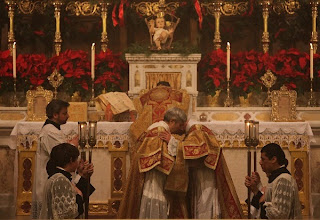The sign of Peace is exchanged at about 1 hr 59 minutes in.
I noticed that at the final Mass at World Youth Day at the exchange of the sign of peace there was the usual chatter and wandering around wishing everyone well - although I can't think why applause broke out as well.
Of course, the New Missal tells us that the exchange of the sign of peace is always optional. The verbal exchange between priest and people is always there but the offering around of a gesture can be omitted. Of course, there is the instruction that the priest should not leave the sanctuary at this point (I suppose the sign value of leaving the Blessed Sacrament to go wandering around the church is counter productive). I've a friend who will often retain a firm hold of the hand of any wayward priest who does leave the sanctuary, while he smiles menacingly at him to say, "Father, you know you're not supposed to be down here just now!"
I was amused to read that historically the exchange of the sign of peace has often become an occasion of conflict and sin. Eamon Duffy tells us that by the sixteenth century, the pax had become a source of discord, with people vying for the honour of receiving it before the others. Debates would break out over who received it first the last time, or who was more worthy to receive it this time. There are documented accounts of physical violence breaking out, and legal action being brought to restrain the over-enthusiastic. In some cases, the pax-brede itself was used as a weapon! It is not surprising, then, to find the rubrics of the Tridentine missal restricting the pax to a more mild-mannered ceremony among the clergy.
A more sedate sign of peace (courtesy of the Society of St Hugh of Cluny)
"In 1494 the wardens of the parish of All Saints, Stanyng [England], presented Joanna Dyaca for breaking the paxbrede by throwing it on the ground, "because another woman of the parish had kissed it before her." On All Saints Day 1522 Master John Browne of the parish of Theydon-Garnon in Essex, having kissed the pax-brede at the parish Mass, smashed it over the head of Richard Pond, the holy-water clerk who had tendered it to him, "causing streams of blood to run to the ground." Brown was enraged because the pax had first been offered to Francis Hamden and his wife Margery, despite the fact that the previous Sunday he had warned Pond, "Clerke, if thou here after givest not me the pax first I shall breke it on thy hedd."
A peaceful scene
At Blackfriars, Oxford (courtesy Godzdogz)













2 comments:
I think the papal liturgy has sunk to a new low. We should pray for the Holy Father.
Fr. A.
You are right Father. The sign of peace is optional, is to be given only to those beside you, and above all, the priest should not leave the sanctuary.
Additionally the traditional sign of peace is a half bow/embrace, not a handshake, which as I have observed elsewhere is more suited to concluding a business deal, or perhaps reaching the top of a difficult mountain.
Some priests leave this dubious, optional practise out, and hopefully more will
Post a Comment